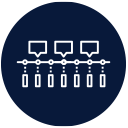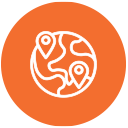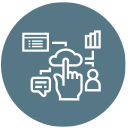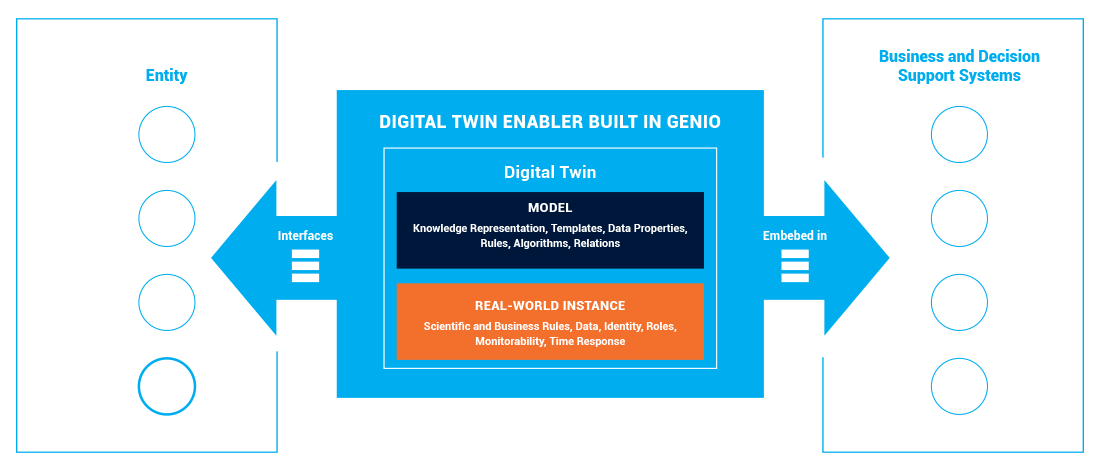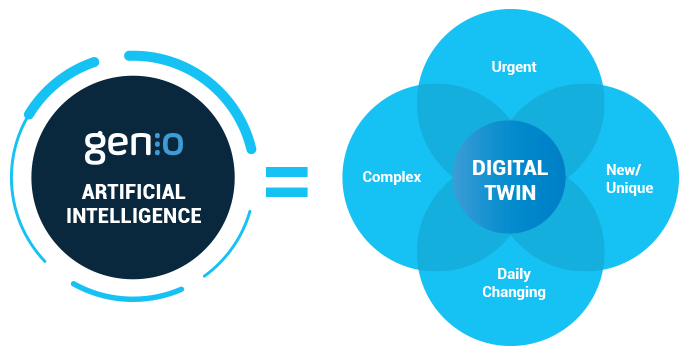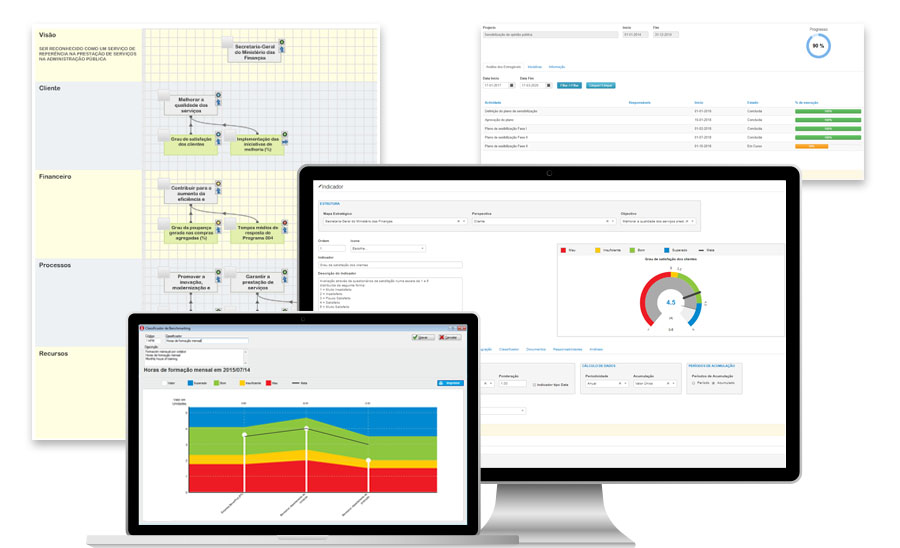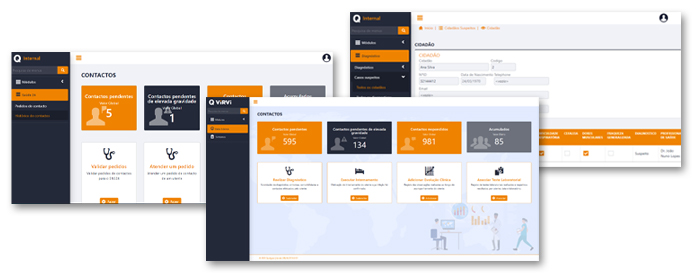Collect information through automatic means, both sensors or automated services, or through crowdsourcing.
WHAT IS A DIGITAL TWIN?
A Digital Twin is a virtual model of a thing, person, process, or socio-economic reality that accurately describes current operations and may also predict future performance for a variety of scenarios for the purpose of optimizing decision outcomes. Digital Twins or Digital Mirrors had their origin in Industry 4.0 and IoT environments. They start to reflect physical things. However, today, there is a consensus that they also encompass people, processes, or socio-economic realities.
Digital Twins of national, regional, or local governments are powerful tools that aim to provide more holistic and near-real-time data support, to enable more effective mid- and long-term policies, namely through regulation and incentives.
POWERFUL FEATURES / ADVANTAGES
TEMPORAL
REAL-TIME
REGIONAL
COMPREHENSIVE
DIGITAL TWIN BY QUIDGEST

WITHIN THE DIFFERENT AREAS, QUIDGEST IS SPECIALIZED IN THE FIELD OF SOCIO-ECONOMIC DYNAMICS
A Socio-Economic Digital Mirror reflects Economics, Demographics, Employment, Digital Skills, Income Distribution, Agriculture, Industrial Production, Banking Performance, Healthcare, Privacy, Security, Social Issues, Regional Issues, Smart Cities, Housing, Environment, Energy, Culture, Sports, External Commerce, Procurement, Entrepreneurship, Investment, R&D, Innovation, Infrastructures, Transports, Communication, Education, Migrations, or Global Sustainable Development. Quidgest clients can count on multidisciplinary teams that have broad experience in both the technological and socio-economic foundations of such a Digital Mirror.
QUIDGEST’s GENIO: TECHNOLOGICAL EDGE THROUGH HYPER-AUTOMATION
Effectiveness of Digital Twins depends on the technological ability to:
Provide a consistent data structure for integration, through clear definitions (just comparing what is comparable).
Share data and validate results from different perspectives.
Pay attention to changes in socio-economic and political agenda, through continuous and fast improvement.
Technological ability requires hyper-agile, hyper-automated software development processes. Quidgest Genio is the ideal platform for developing, using, and fully leveraging a Digital Twin for data-driven decision-making, planning, and policy development. The scarcest and most valuable resource for creating a Digital Twin (and generally for all AI applications) is not the way to graphically compose existing data, but the ability to quickly collect new consistent data.
Quidgest has been, for 30 years, a pioneer in using Models and Artificial Intelligence for software development, producing information systems at a higher level of abstraction, using Models as the right way to fill the worldwide gap for optimized digital transformation solutions.
Through Genio platform, every system is developed for a real mirror. We complement it with our advantage proven systems, such as Balanced Scorecard (BSC), to monitor the present while predicting the future. And to prove that this is not science fiction, we have VirVi system already developed in record time during the COVID-19 pandemic, which personalizes all of these concepts.
GARTNER RESEARCH
Quidgest mentioned as a Sample Provider in the Digital Twin component by Gartner®. See Gartner Research here:
- Gartner, “Emerging Technologies and Trends Impact Radar: Enterprise Software”, John Kostoulas, Balaji Abbabatulla, et-al., October 4, 2021
- Gartner, “Emerging Technologies and Trends Impact Radar: Internet of Things”, Matthew Flatley, Eric Goodness, et-al., September 30, 2021
- Gartner, “Emerging Technologies and Trends Impact Radar: Hyperautomation”, Cathy Tornbohm, November 30, 2020
- Gartner, “Emerging Technologies and Trends Impact Radar: 2021”, Tuong Nguyen, Martin Reynolds, et-al., November 21, 2020
GARTNER is registered trademark and service mark of Gartner, Inc. and/or its affiliates in the U.S. and internationally and is used herein with permission. All rights reserved. Gartner does not endorse any vendor, product or service depicted in its research publications, and does not advise technology users to select only those vendors with the highest ratings or other designation. Gartner research publications consist of the opinions of Gartner’s research organization and should not be construed as statements of fact. Gartner disclaims all warranties, expressed or implied, with respect to this research, including any warranties of merchantability or fitness for a particular purpose.
BALANCED SCRORECARD
The Digital Twin can be complemented with a proactive approach, relying on Quidgest Balanced Scorecard to
- Reflect on, and redefine, Values, Missions, and Strategies.
- Break the strategies down into Expected Results, Targets, Process Improvement, Innovation, and Required Resources.
- Execute strategies through consistent KPIs and SMART goals over time.
- Monitor, in nearly real-time, the execution of each approved Strategy.
- Improve the execution and the whole Strategy, through delegated responsibilities.
VIRVI
VirVi is a hyper-agile emergency software, backed by a structured data lake, both provided by Quidgest, for epidemiologic global challenges like COVID-19. It acts as a Digital Twin of the reality created by COVID-19. Any important information related to COVID-19 is reflected in VirVi.
- This Digital Twin has been translated to distinct software modules, used for Global Public Health Decisions
- Global Social Care Management
- Citizen’s Self-Assessment
- Nursing Homes Management, namely as Shared Services provided to several nursing homes)
- Medical Support/Advice Lines
- LIMS, namely for improvised emergency labs
STEPS TO ACHIEVE A DIGITAL TWIN
1. DEFINITION OF A DIGITAL TWIN FOR A GOVERNMENT OR PUBLIC ORGANIZATION
UNDERSTANDING PRIMARY AND SECONDARY SOURCES
A Digital Twin design is different where it is built on primary or secondary sources.
Primary sources reflect the raw data, one by one, at a specific location and time: a student admission to a college, a product exported to a country, a birth, an investment approved, a measurement of air quality, an amount of production achieved, etc..
Secondary sources are aggregated data, provided without individual references, thus without privacy concerns. A Government must be built on secondary sources, ensuring some key features:
- Relying on secondary data collection requires and gives evidence that all entities are doing their job.
- To be effective, Digital Mirrors built on secondary sources must still be automatic, to remain an accurate, useful, and on-time reflection of reality. These are fundamental features of a Digital Mirror.
- All the raw data dimensions must be preserved (location, dates, ages, values, quantities, dispersion).
- Cascading Digital Mirrors may be required. That means, a hierarchy of lower level Digital Mirrors. Drill Down capabilities are an interesting addition.
- Confidence levels on Data Quality, from estimate to final/checked/audited, must be embedded in the Digital Mirror.
IDENTIFYING LEADING INDICATORS
A Digital Mirror is not a rearview mirror. On the contrary, the goal of a Digital Mirror is to look forward and influence future performance.
The best way to predict our future is to create it.
Therefore, the focus is on leading indicators. Common leading indicators are metrics like consumer expectations, enterprise forecasts, job offers, order books, new orders, raw materials sales, energy consumption, inventory levels, retail sales, building permits, hotel reservations, new businesses, ATM withdrawals, electronic payments, or stock prices. These indicators are more useful when considered not as an aggregate but when distributed by different dimensions (namely, timeframe, country, region, or economic sector).
REPRESENTING SCENARIOS AND SIMULATION
A Digital Twin is a Model.
A Model requires knowledge representation. The Governments’ reality must be translated to the Model, no matter how difficult (and innovative) this task can be.
Seeking to achieve a particular purpose, causal relations and interactions must be explicit. Data science, supported by both traditional econometrics and machine-learning, can uncover these relations. Strategy Maps, from the Balanced Scorecard tool, offer a basis for this explicitness. By changing parameters in the Model, a Government Digital Mirror can develop Scenarios and Simulations, using predictive methods.
Simulations are not intrusive, neither destructive. Several exercises can be executed, over the variables where Governments have some control to tune up socio-economic policies.
RESEARCH
Economic recovery policies have been around for nearly 90 years. However, no one knows the potential of the currently available IT (computer power, data science, artificial intelligence) to leverage the positive effects of these policies. Where, 90 years ago, only aggregate values (C, I, G, M, X) were used, now we can build digital twins of Economies and Societies, with hundreds of thousands of values.
Is this potential capillarity a factor of efficiency and effectiveness?
A Government’s Digital Twin is an important factor for an effective recovery, faster and at less cost. If this assumption is correct, it would be reasonable to rethink socio-economic science for the XXI century, integrating all the possibilities opened up by information technologies and artificial intelligence advances, namely through the Digital Twin concept.
It makes sense, therefore, to invite Researchers to follow and explore this innovative approach.
2. IMPLEMENTATION PLANNING
3. RESOURCES ALLOCATION
4. INVESTMENT
5. RETURN ON INVESTEMENT
ABOUT
Quidgest is a global technology company headquartered in Lisbon and a pioneer in intelligent software modeling and generation. Through its unique generative AI platform, Genio, develops complex, urgent, and specific systems, ready to evolve continuously, flexible, and scalable for various technologies and platforms. Partners and large organizations such as governments, multinational companies, and global multilateral institutions use Quidgest’s solutions to achieve their digital strategies.
FUTURE-READY SOFTWARE
CONTACTS
R. Viriato, 7
1050-233 Lisboa | Portugal
Tel. +351 213 870 563
quidgest@quidgest.com


